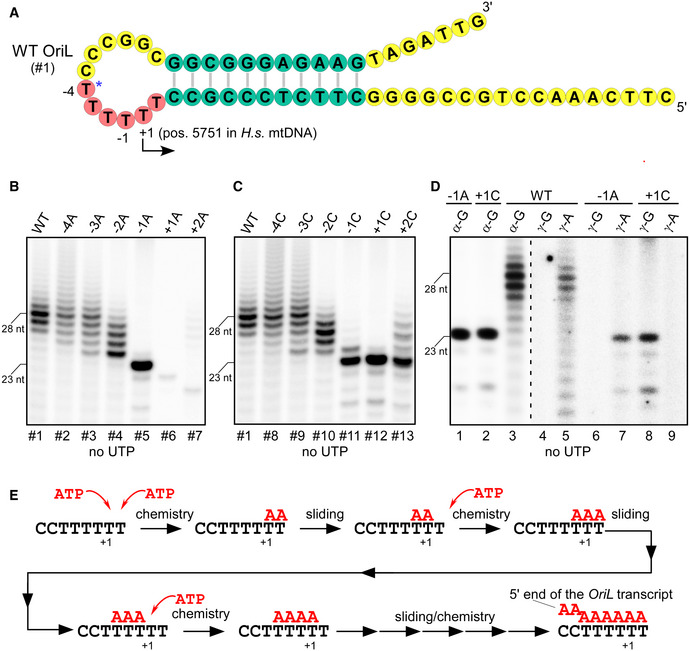-
A
Schematic representation of the human OriL stem‐loop structure. Human OriL comprises a 12 nt loop and an 11 bp stem. The conserved residues of the OriL stem are shown as green circles and the stretch of the dTMP residues harboring the transcription initiation site are in pink. Non‐conserved sequence in the loop and sequences beyond the stem region are shown in yellow. The OriL transcription initiation start site (+1) is shown as determined in this work (bent arrow) and its location in the human mtDNA (accession
NC_012920.1) is indicated.
-
B, C
Transcription initiation at OriL involves transcript slippage. The products of transcription by mtRNAP in the presence of a limiting set of substrates (ATP, CTP, and GTP) are shown. Transcription assays were performed using either the WT OriL as DNA template or OriL variants, in which particular dTMP residues in the T‐stretch region were substituted with either dAMP (B) or dCMP (C). The substitutions are specified above each lane and the corresponding template numbers are listed below the images. The labels on the left indicate the length of transcripts.
-
D
Identification of the OriL transcription start site. Transcription assays were performed involving the WT and mutant −1A and +1C OriL templates, as indicated on the top, in the presence of ATP, CTP, and GTP. The transcription products were labeled either at each GMP residue by adding [α‐32P]‐GTP to the substrate mixtures or at their 5’ ends by utilizing [γ‐32P]‐initiating nucleotides, ATP or GTP, as indicated above each lane.
-
E
Schematic illustration of the process of transcript slippage at OriL. A portion of the OriL loop is shown in black in the 3′ to 5′ direction with the transcription start site indicated as +1. Two substrate ATP molecules (red) base‐pair the templating T bases at positions +1 and +2 as shown. Upon formation of the first phosphodiester bond, the resulting AA transcript (red) slides along the DNA template to base‐pair the −1 and +1 T bases. This vacates the substrate‐binding site opposite the +1 T base. Incorporation of another AMP residue results in extension of the nascent transcript, which in turn also “slips” along the DNA template as shown. The nucleotide incorporation and RNA slippage steps then continue. Note that the slippage ultimately results in the formation of a 6 bp long RNA–DNA hybrid because of the presence of six templating T residues in the human OriL.

